Family : Lamprophiidae

Text © Dr. Nicolò Pellecchia

English translation by Mario Beltramini
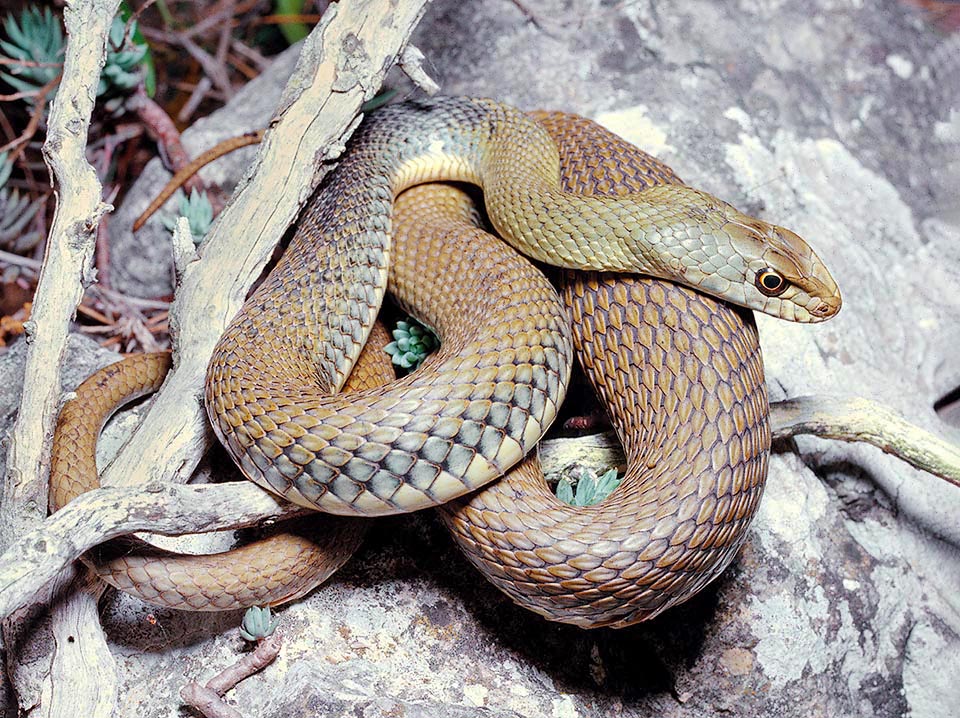
Even 2 m long, Malpolon monspessulanus is present in western Liguria, south-east France and after the Iberian Peninsula, in Morocco and north-western Algeria © G. Mazza
The Lacertine snake or Montpellier snake, Malpolon monspessulanus (Hermann, 1804), is an ophidian reptile belonging to the order of the Squamata, family Lamprophiidae that includes about 90 species, widespread mainly in Africa.
It is a very diversified family of snakes, and it is possible to observe different adaptations, from digging to semi aquatic snakes that live in many types of environments, like mountains, deserts, tropical forests and others.
The etymology of the generic epithet Malpolon is not entirely clear, however it is possible to formulate at least two hypotheses.
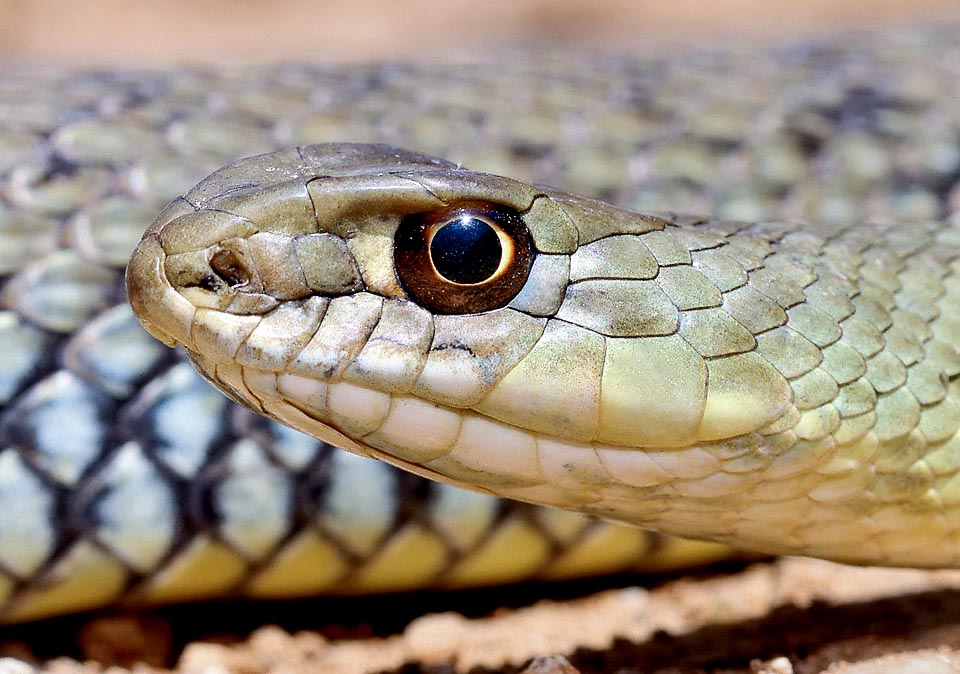
It has big eyes with round pupil and very prominent cephalic scales that form a menacing eyebrow © Fernando Iglesias
The first refers to the derivation from a dialect of Tamil, population of Sri Lanka, where this term should indicate a species of snake.
Malpolon should have been used for the first time by two naturalists of the 17th century, John Ray and Albertus Seba, before the introduction of the binomial nomenclature done by Linnaeus, and was later on adopted by Fitzinger in 1826 for the description of the genus.
The second hypothesis comes from the generic name from the Latin “mal”, bad and from the Greek “πόλος” (pólos) board, pole, bad pole, to indicate the erect position assumed by the snake to control the surroundings and its aggressive character.
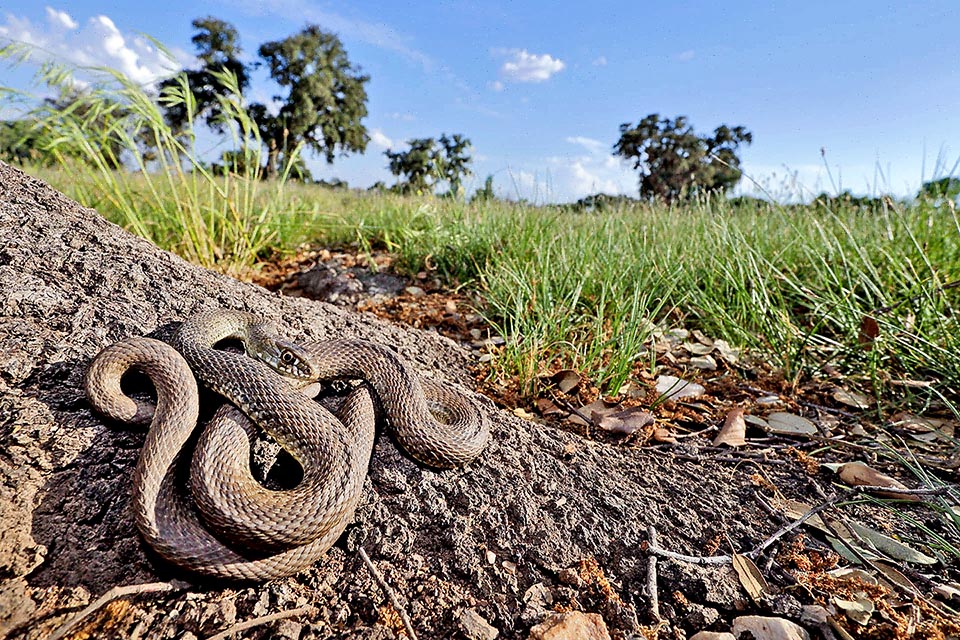
Can be met in various sites up to more than 2000 m of altitude. Loves dry and rocky soils, like garrigue, but well adapts to anthropized or country areas © Fernando Iglesias
The specific epithet monspessulanus comes from Latin, and is a form for indicating the city of Montpellier, place of origin of the specimen described by Hermann.
To date the genus Malpolon presents three species, the Eastern Montpellier snake (Malpolon insignitus), the False cobra (Malpolon moilensis), and the Lacertine snake (Malpolon monspessulanus).
Zoogeography
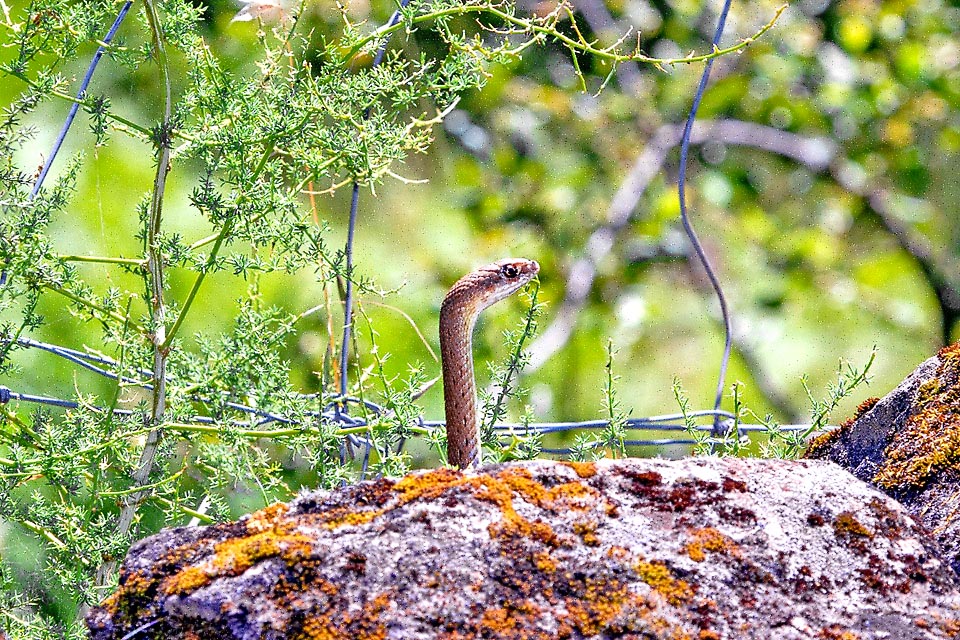
Risen in an orchard near a fence to see if there are dangers or preys. It hunts lizards, geckos, luscengolas, blindworms, snakes, small mammals and birds © David Fischer
The distribution range of Malpolon monspessulanus includes, north, the western part of Liguria and the south east of France, to then go down along the Iberian Peninsula, up to Morocco and north-eastern Algeria.
Ecology-Habitat
It is a species frequenting an ample altitudinal range, between the sea level and the 2160 metres. It prefers dry and rocky soils, but adapts well to various environments of Mediterranean type. It is not rare to observe it also in anthropized or country areas, like terraces planted with vines or olive trees.
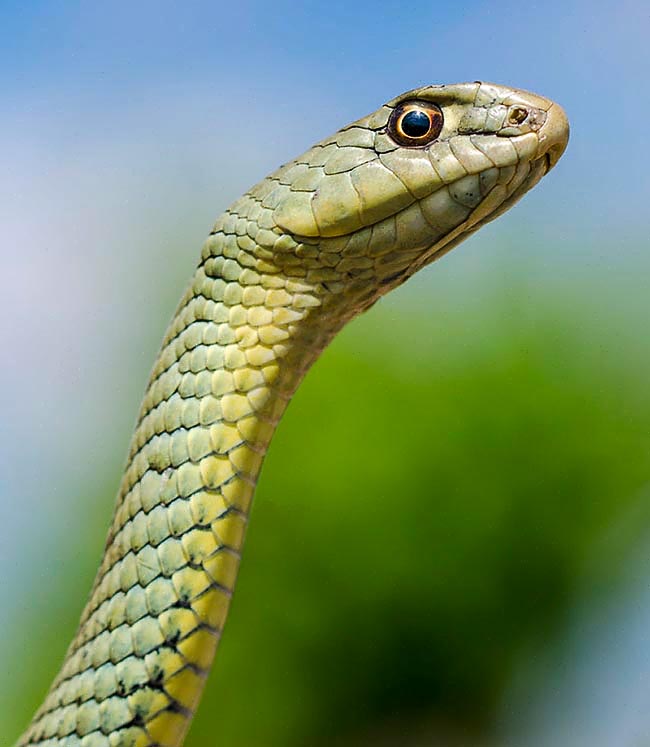
Malpolon monspessulanus is a opisthoglyphous snake, that is with grooved venom teeth located at bottom of the jaw, and so of little danger for man, also because the venom has a very slow action going from 24 to 48 hours © Noham Trigaud
Its period of activity stands mainly between April and October, with maximum peaks observed generally in May and September.
It is a typically diurnal snake but in the warmest months tends to become crepuscular and nocturnal.
They are agile and fast predators. They prey following different styles, such as the ambush, the chase or the active search of the prey.
To kill its prey it utilizes the venom which has a slow action, between 24 and 48 hours.
Its diet is mainly formed by other reptiles, especially lizards, but also geckoes, luscengolas, blindworms or other snakes. Besides these the Lacertine snake eats small mammals and birds.
Among the main predators of this species we find several mammals, such as the fow or the boar, and the birds of prey.
Morphophysiology
It is a snake of considerable size, with an elongated and muscular shape.
The males, that grow up to 181 cm, are bigger than the females who measure 108 cm in length, Exceptionally, some individuals exceed two metres, up to 250 cm.
Its colour is variable. Among the palearctic snakes it is the species presenting the strongest sexual dimorphism.
The females and the juveniles have a greyish brown colour, alternated by more or less dark spots juxtaposed at. times also by reddish shades.
When adults, the males assume a colouration that can vary from grey to olive or brownish green. In both sexes, but more typical in the males, is the presence of a saddle-shaped spot on the dark coloured neck.
Another character of sexual dimorphism is the colour of the belly, with white-yellowish background, that is much more spotted in females than in the male.
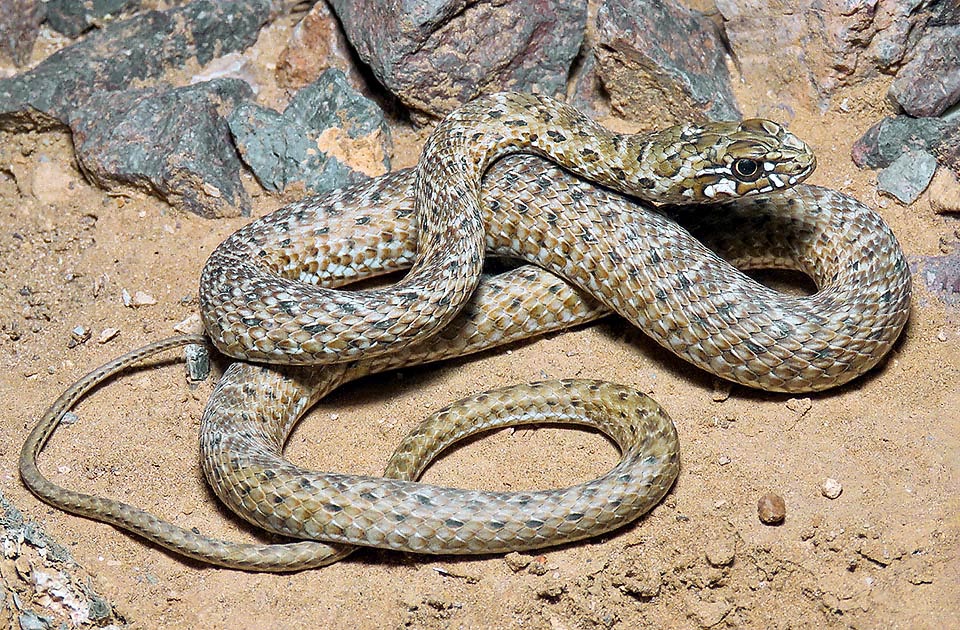
There is a very strong sexual dimorphism. The females, smaller, are not olive green or brownish like the males, but have a livery with dark spots emphasized by clear strokes in reddish grey background. They may lay, after the size, 4 to 18 eggs, in humid and sunny sites, in the litter or under trunks and big stones © Justin Ilee
The colour of the females is more evident already from a young age, thus allowing a distinction of the sex even before the achievement of sexual maturity.
The Montpellier snake has two big eyes with round pupils, over which stand some very protruding cephalic scales that appear to form an eyebrow.
The scales on the back present a groove, and are arranged in 19 rows.
It is an opisthoglyphous snake that presents the venom teeth in the mostly back zone of the jaws.
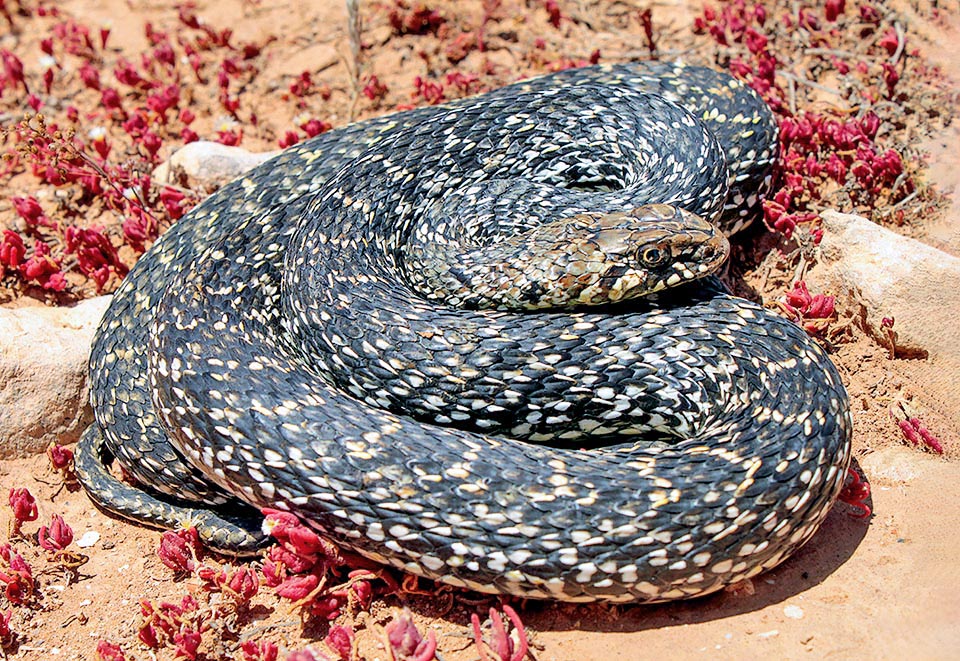
The subspecies Malpolon monspessulanus saharatlanticus, present in Morocco and in west Sahara, often has a very dark lifery © Karim Chouchane
These teeth are grooved to channel venom during the bite.
Because of this arrangement of the teeth, the opisthoglyphous snakes have difficulties in venoming large preys, the reason why, generally, they are considered as not dangerous for the man. Conversely, with small preys, they are able to be very efficient, managing to move them immediately into the back part of the mouth.
Ethology-Reproductive Biology
Malpolon monspessulanus is an oviparous species. The love period usually begins in April and ends in June.
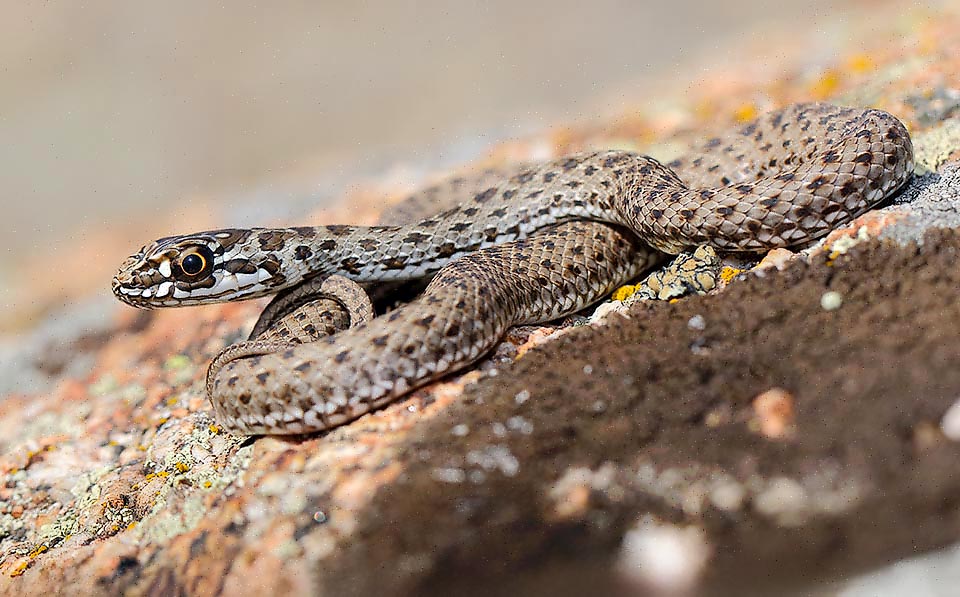
Juvenile basking in the sun. Its livery with black spots is quite similar to the female one © Fernando Iglesias
During this time the males actively search for the females, and fight with other conspecifics.
The female lays 4 to 18 eggs, depending on the body size, in humid and sunny places, like trunks, litter or big stones. In rare instances have been observed eggs and juveniles in big groups, which indicates a type of colonial nesting.
After some observations it seems that the males of Lacertine snake mark the territory with chemical signals, to prevent other males from approaching their own partner. The males that enter the territory of the couple get bitten, or, alternatively, clash in ritual fights. It has also been observed that the losers may remain in the territory, acting as helpers to the alpha male, defending the area while he is around.
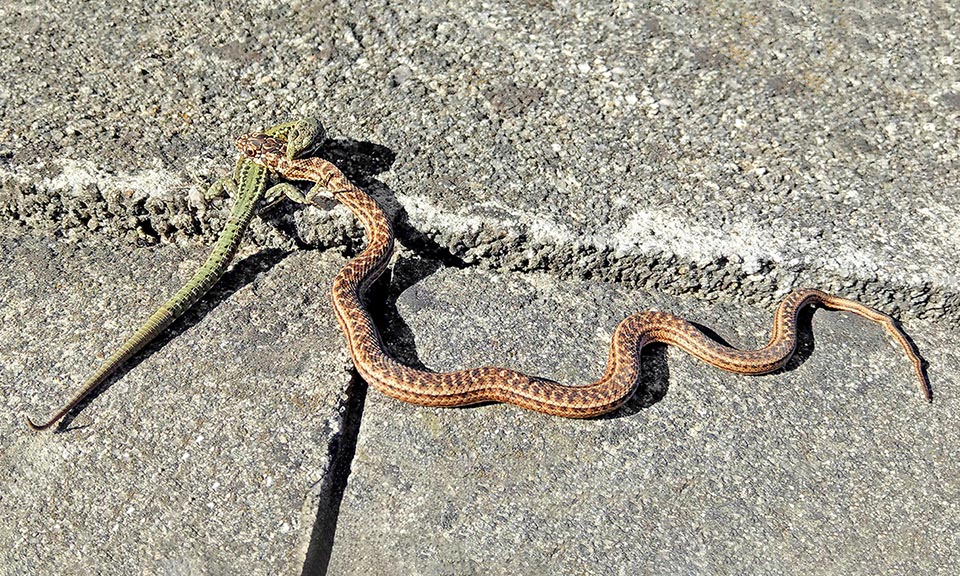
This has just caught a lizard who defends by biting its neck, but there is no escape because it has moved her into the back of the mouth where the venom teeth stand © Aitor Freire Astray
It is a very watchful snake and presents a lookout attitude to monitor its surroundings. Every now and then it rises and begins to move the head to all sides, to peer possible predators in ambush.
As soon as it perceives the presence of a predator it flees very quickly. If it fails to escape it tries to threaten the predator by rising, while producing a loud hiss it swells the head and compresses the neck area.
The Lacertine snake is a fairly common species all over its range, and the populations appear to be very stable. The main threats for this species are linked to the man, like the roads, or the abandoned wells into which they fall, very frequent especially in Morocco.
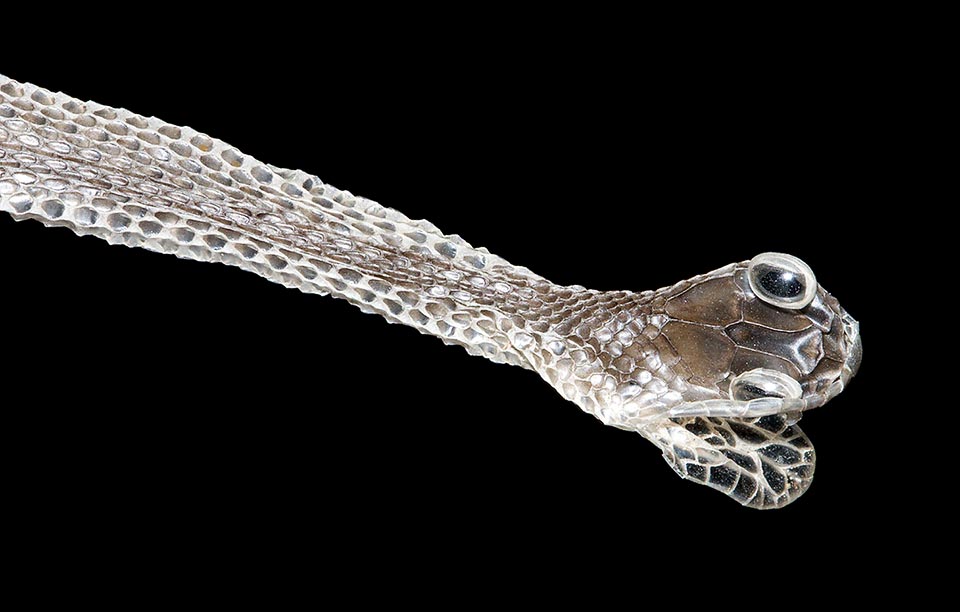
Almost intact exuvia of an adult’s moult. If you find it along a path there is a Malpolon monspessulanus thereabout. But don’t worry, you will see it fleeing fast © G. Mazza
Malpolon monspessulanus is assigned to the category LC, Least Concern in the IUCN Red List of the endangered species.
Synonyms
Coluber monspessulanus Hermann, 1804; Natrix lacertina Wagler, 1824; Coluber rupestris Risso, 1826; Rhabdodon fuscus Fleischmann, 1831; Psammophis lacertina Schlegel, 1837; Coelopeltis lacertina Eichwald, 1841; Coluber monspeliensis Gervais, 1848; Caelopeltis lacertina Boettger, 1876; Caelopeltis lacertina Boettger, 1879; Coelopeltis monspessulana neumayeri Boettger, 1889; Coelopeltis lacertina Boulenger, 1887; Coelopeltis monspessulanus Boulenger 1896; Malpolon monspessulanus Mertens & Müller, 1928.
→ For general notions about Serpentes please click here.
→ To appreciate the biodiversity within the SNAKES please click here.
